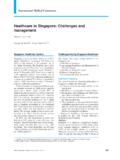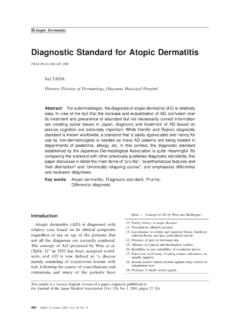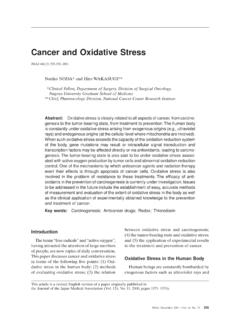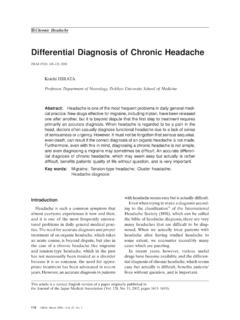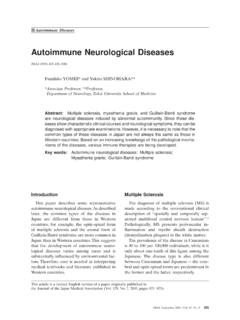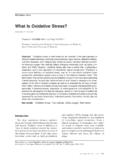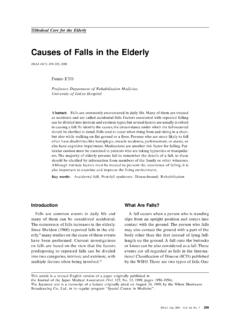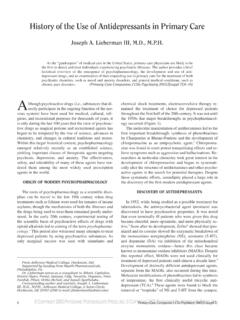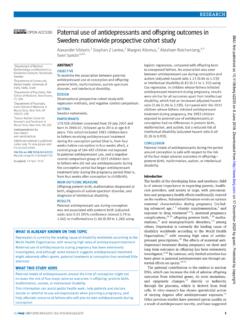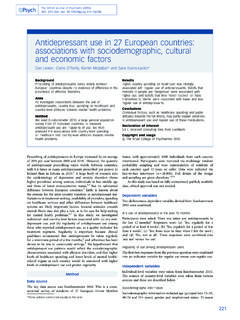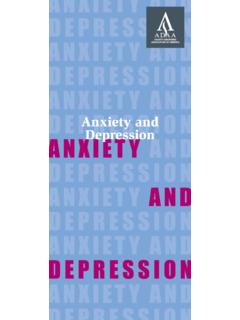Transcription of Characteristics and Use of New Antidepressant Drugs
1 JMAJ, June 2004 Vol. 47, No. 6265 IntroductionJapan has been considered to be at least tenyears behind international standards in its useof antidepressants, because selective serotoninreuptake inhibitors (SSRIs), the mainstreamantidepressants used in Europe, North America,and elsewhere, were introduced late in Japan,forcing Japanese physicians to depend on tricy-clic antidepressants, an older generation ofdrugs for the treatment of , in 1999, the first SSRI, fluvoxamine,was introduced in Japan, and another SSRI,paroxetine, became available the followingyear. Subsequently, milnacipran, a serotonin-noradrenaline reuptake inhibitor (SNRI), oneof the newer Antidepressant Drugs , also becameavailable, creating rapid changes and new devel- Characteristics and Use ofNew Antidepressant DrugsJMAJ 47(6): 265 269, 2004 Soichiro NOMURAP rofessor, Department of Psychiatry, National Defense Medical CollegeAbstract.
2 Japan has been considered at least ten years behind internationalstandards in its use of Antidepressant Drugs , because selective serotonin reuptakeinhibitors (SSRIs), which are mainstream antidepressants in Europe and NorthAmerica, were not introduced in Japan until recently, and conventional tricyclicantidepressants had to be used instead. The first SSRI became available in Japanin 1999, followed by a newer type of Antidepressant , , serotonin-noradrenalinereuptake inhibitors (SNRIs), leading to more advanced treatment of are similar to conventional tricyclic antidepressants in their rate and onsetof efficacy. However, since they act only on serotonin, they are associated withfewer side effects, and thus are easier for both patients and physicians to potentiate the action of norepinephrine in addition to that of serotonin, and,theoretically, are expected to be more potent than SSRIs.
3 However, their charac-teristics are similar to those of SSRIs. These new antidepressants are expected tobe effective for anxiety disorders as well as depression, and may be useful inhelping reduce the overprescription of benzodiazepine derivatives in words: Antidepressant ; SSRI; SNRI; DepressionThis article is a revised English version of a paper originally published inthe Journal of the Japan Medical Association (Vol. 129, No. 2, 2003, pages 193 196).The Japanese text is a transcript of a lecture originally aired on October 16, 2002, by the Nihon ShortwaveBroadcasting Co., Ltd., in its regular program Special Course in Medicine . Psychotropic Drugs266 JMAJ, June 2004 Vol.
4 47, No. 6of these receptors causes side effects includingthirst, constipation, drowsiness, and dizzinesson standing, leading patients to regard themas problematic and to take a negative attitudetoward treatment. In addition, the tricyclic anti-depressants induce an increase in ocular ten-sion, making them difficult to use in patientswith narrow-angle glaucoma. They may alsoworsen difficulty in urination in patients withbenign prostatic hyperplasia, so that cautionregarding their use is necessary in such , they can be difficult to use in the face ofconcomitant physical of these drawbacks, tricyclic anti-depressants failed to gain the unmitigated trustof patients and physicians alike, despite theirfairly high rate of efficacy.
5 The attempt to over-come these drawbacks provided the impetus forthe development of new Antidepressant and Use of SSRIsAmong the new antidepressants, SSRIs willbe discussed first. Five of the Drugs in this cat-egory are used throughout the world, and twoof them, fluvoxamine (Luvox , Depromel )and paroxetine (Paxil ), are available in are characterized by their relativelyuncomplicated chemical properties. As men-tioned previously, conventional tricyclic anti-depressants not only have a potent inhibitoryaction on the reuptake of noradrenaline andserotonin in brain cells but also have blockingactions on various receptors in the body, result-ing in substantial side , SSRIs have hardly any such block-ing effects, and their chemical action serves toinhibit serotonin reuptake alone.
6 Thus, theirside effects are minimal, while their rate ofefficacy is similar to that of the tricyclic anti-depressants. Thus, SSRIs are considered to havenone of the undesirable effects of the tricyclicantidepressants, while managing to retain theiruseful some consider an efficacy ratesimilar to that of the tricyclic antidepressantsopments in the use of Antidepressant paper describes the use of these anti-depressant Drugs according to their character-istics and side and Problems ofConventional Tricyclic AntidepressantsIt is important to look initially at the prop-erties and problems of Antidepressant Drugs ofthe previous antidepressants were first developedabout 40 years ago.
7 As mentioned above, theywere the main antidepressants administeredclinically in Japan until recently. Imipramine,a representative tricyclic Antidepressant , wasgradually improved, to produce a number ofother newer tricyclic antidepressants. The basicproperties of the newer derivatives are similarto those of imipramine; they inhibit the reup-take of serotonin and noradrenaline in nervecells in the brain, thereby enhancing neuraltransmission and exerting an results of previous clinical trails indicatethat the efficacy rate of tricyclic antidepres-sants in patients with depression is about 70%,a reasonably good rate.
8 On the whole, tricyclicantidepressants can be regarded as effectivedrugs. However, the fact remains that about30% of patients do not respond adequately tothese Drugs , and efforts to increase efficacy areimportant. In addition, tricyclic antidepressantsrequire 3 4 weeks of uninterrupted therapy atadequate doses before their effects manifest. Inother words, they are not fast-acting. Becausedepression is distressing to the patient andcarries a high risk of suicide, the slow actionof Drugs in this class is a detriment to , a greater problem in the use oftricyclic antidepressants is their substantial sideeffects, the greatest drawback of Drugs in thisclass.
9 All tricyclic antidepressants block centraland peripheral muscarinic receptors, histaminereceptors, and 1 adrenergic receptors. , June 2004 Vol. 47, No. 6267 NEW Antidepressant sufficient dose. After that the same drug shouldbe used continuously for at least 3 4 weeks toexamine the patient s response. If therapy is noteffective, switching to a tricyclic antidepressantor a serotonin-noradrenaline reuptake inhibitor(SNRI) should be considered. Caution shouldbe exercised if other Drugs are being and Use of SNRIsThe most recently developed antidepressantsare the serotonin-noradrenaline reuptake inhibi-tors (SNRIs). In Japan, milnacipran (Toledo-min ) has been used for two years, and currentlyit is the only SNRI Antidepressant mentioned previously, SSRIs may be lesseffective for severe cases than tricyclic anti-depressants because SSRIs inhibit the reup-take of serotonin alone and do not activatenoradrenaline.
10 Enhancing the function of asingle neurotransmitter is not sufficient todiminish this regard, Drugs that activate both sero-tonin and noradrenaline, like the tricyclic anti-depressants, do not have unfavorable effectssuch as blockade of muscarinic receptors andhistamine receptors, and may be ideal in termsof potent clinical effects and minimal sideeffects. SNRIs were developed on the basis ofthis hypothesis. Thus, SNRIs are not justempirical Drugs , but Drugs that have beendeveloped on the basis of a , from a theoretical point of view,a great deal is expected from the SNRIs. How-ever, the clinical impression of SNRIs has beensimilar to that of SSRIs.
